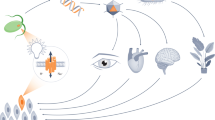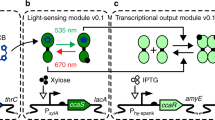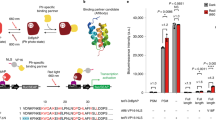Abstract
Optogenetic tools use colored light to rapidly control gene expression in space and time. We designed a genetically encoded system that gives Escherichia coli the ability to distinguish between red, green, and blue (RGB) light and respond by changing gene expression. We use this system to produce 'color photographs' on bacterial culture plates by controlling pigment production and to redirect metabolic flux by expressing CRISPRi guide RNAs.
This is a preview of subscription content, access via your institution
Access options
Access Nature and 54 other Nature Portfolio journals
Get Nature+, our best-value online-access subscription
$29.99 / 30 days
cancel any time
Subscribe to this journal
Receive 12 print issues and online access
$259.00 per year
only $21.58 per issue
Buy this article
- Purchase on Springer Link
- Instant access to full article PDF
Prices may be subject to local taxes which are calculated during checkout



Similar content being viewed by others
References
Deisseroth, K. Nat. Methods 8, 26–29 (2011).
Bacchus, W. & Fussenegger, M. Curr. Opin. Biotechnol. 23, 695–702 (2012).
Segall-Shapiro, T.H., Meyer, A.J., Ellington, A.D., Sontag, E.D. & Voigt, C.A.A. Mol. Syst. Biol. 10, 742 (2014).
Gambetta, G.A. & Lagarias, J.C. Proc. Natl. Acad. Sci. USA 98, 10566–10571 (2001).
Levskaya, A. et al. Nature 438, 441–442 (2005).
Rockwell, N.C. & Lagarias, J.C. ChemPhysChem 11, 1172–1180 (2010).
Hirose, Y., Shimada, T., Narikawa, R., Katayama, M. & Ikeuchi, M. Proc. Natl. Acad. Sci. USA 105, 9528–9533 (2008).
Tabor, J.J., Levskaya, A. & Voigt, C.A. J. Mol. Biol. 405, 315–324 (2011).
Möglich, A., Ayers, R.A. & Moffat, K. J. Mol. Biol. 385, 1433–1444 (2009).
Stanton, B.C. et al. Nat. Chem. Biol. 10, 99–105 (2014).
Tabor, J.J. et al. Cell 137, 1272–1281 (2009).
Lou, C., Stanton, B., Chen, Y.J., Munsky, B. & Voigt, C.A. Nat. Biotechnol. 30, 1137–1142 (2012).
Nielsen, A.A. et al. Science 352, aac7341 (2016).
Sleight, S.C., Bartley, B.A., Lieviant, J.A. & Sauro, H.M. J. Biol. Eng. 4, 12 (2010).
Chen, Y.J. et al. Nat. Methods 10, 659–664 (2013).
De Mey, M., De Maeseneire, S., Soetaert, W. & Vandamme, E. J. Ind. Microbiol. Biotechnol. 34, 689–700 (2007).
Qi, L.S. et al. Cell 152, 1173–1183 (2013).
Purnick, P.E. & Weiss, R. Nat. Rev. Mol. Cell Biol. 10, 410–422 (2009).
Rockwell, N.C. et al. Proc. Natl. Acad. Sci. USA 111, 3871–3876 (2014).
Shimizu-Sato, S., Huq, E., Tepperman, J.M. & Quail, P.H. Nat. Biotechnol. 20, 1041–1044 (2002).
Buckley, C.E. et al. Dev. Cell 36, 117–126 (2016).
Lee, J.M., Lee, J., Kim, T. & Lee, S.K. PLoS One 8, e52382 (2013).
Magaraci, M.S. et al. ACS Synth. Biol. 3, 944–948 (2014).
Miyake, K. et al. Biotechnol. Biofuels 7, 56 (2014).
Farzadfard, F. & Lu, T.K. Science 346, 1256272 (2014).
Datsenko, K.A. & Wanner, B.L. Proc. Natl. Acad. Sci. USA 97, 6640–6645 (2000).
Moser, F. et al. ACS Synth. Biol. 1, 555–564 (2012).
Tabor, J.J. Methods Enzymol. 497, 373–391 (2011).
Gerhardt, K.P. et al. Sci. Rep. 6, 35363 (2016).
Schmidl, S.R., Sheth, R.U., Wu, A. & Tabor, J.J. ACS Synth. Biol. 3, 820–831 (2014).
Ohlendorf, R., Vidavski, R.R., Eldar, A., Moffat, K. & Möglich, A. J. Mol. Biol. 416, 534–542 (2012).
Tian, T. & Salis, H.M. Nucleic Acids Res. 43, 7137–7151 (2015).
Acknowledgements
The authors would like to thank N. DeLateur and R. Weiss for assistance with fluorescence microscopy and L. Gonzalez for assistance with hardware. This work was supported by US National Science Foundation Synthetic Biology Engineering Research Center (SynBERC EEC0540879), the Office of Naval Research Multidisciplinary University Research Initiative (N00014-11-1-0725 and N00014-13-1-0074), and the National Institutes of Health (R01-GM095765 and R01-GM096164).
Author information
Authors and Affiliations
Contributions
C.A.V., J.F.-R., and F.M. conceived of the study and designed the experiments. J.F.-R. and F.M. performed the experiments and analyzed the data. M.S. designed and built the genomic gusBC system. C.A.V., J.F.-R., and F.M. wrote the manuscript.
Corresponding author
Ethics declarations
Competing interests
The authors declare no competing financial interests.
Supplementary information
Supplementary Text and Figures
Supplementary Results, Supplementary Note, Supplementary Table 1 and Supplementary Figures 1–13 (PDF 32038 kb)
Rights and permissions
About this article
Cite this article
Fernandez-Rodriguez, J., Moser, F., Song, M. et al. Engineering RGB color vision into Escherichia coli. Nat Chem Biol 13, 706–708 (2017). https://doi.org/10.1038/nchembio.2390
Received:
Accepted:
Published:
Issue Date:
DOI: https://doi.org/10.1038/nchembio.2390
This article is cited by
-
Production of biliverdin by biotransformation of exogenous heme using recombinant Pichia pastoris cells
Bioresources and Bioprocessing (2024)
-
Synthetic microbiology in sustainability applications
Nature Reviews Microbiology (2024)
-
A biological camera that captures and stores images directly into DNA
Nature Communications (2023)
-
Phaseolus lunatus L.: pulse seeds phenotype image analysis
Genetic Resources and Crop Evolution (2023)
-
A micro-nano optogenetic system based on probiotics for in situ host metabolism regulation
Nano Research (2023)



